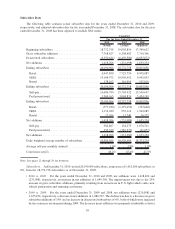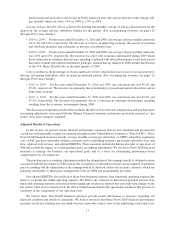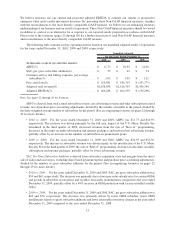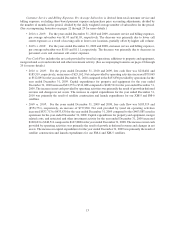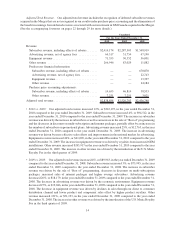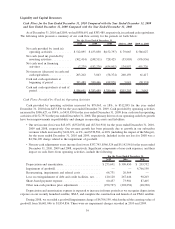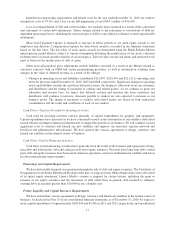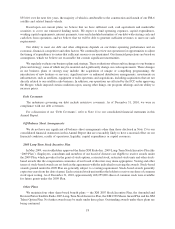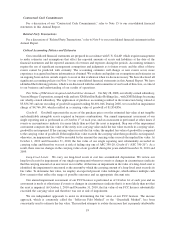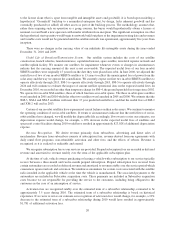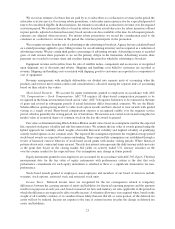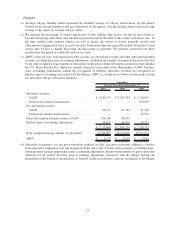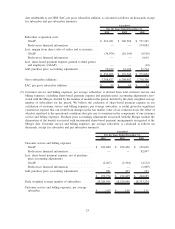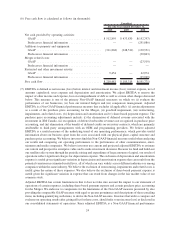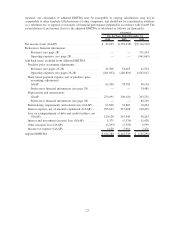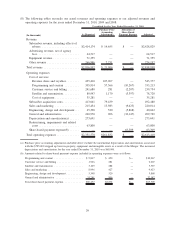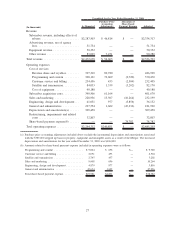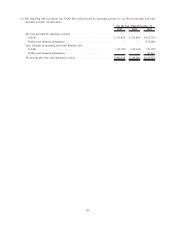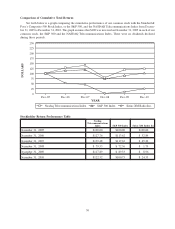XM Radio 2010 Annual Report Download - page 76
Download and view the complete annual report
Please find page 76 of the 2010 XM Radio annual report below. You can navigate through the pages in the report by either clicking on the pages listed below, or by using the keyword search tool below to find specific information within the annual report.to the license alone (that is, apart from tangible and intangible assets and goodwill). It is based upon modeling a
hypothetical “Greenfield” build-up to a normalized enterprise that, by design, lacks inherent goodwill and has
essentially purchased (or added) all other assets as part of the build-up process. The methodology assumes that,
rather than acquiring such an operation as a going concern, the buyer would hypothetically obtain a license at
nominal cost and build a new operation with similar attributes from inception. The significant assumption was that
the hypothetical start up entity would begin its network build out phase at the impairment testing date and revenues
and variable costs would not be generated until the satellite network was operational, approximately five years from
inception.
There were no changes in the carrying value of our indefinite life intangible assets during the years ended
December 31, 2010 and 2009.
Useful Life of Broadcast/Transmission System. Our satellite system includes the costs of our satellite
construction, launch vehicles, launch insurance, capitalized interest, spare satellite, terrestrial repeater network and
satellite uplink facility. We monitor our satellites for impairment whenever events or changes in circumstances
indicate that the carrying amount of the asset is not recoverable. The expected useful lives of our four in-orbit
SIRIUS satellites were originally 15 years from the date they were placed into orbit. In June 2006, we adjusted the
useful lives of two of our in-orbit SIRIUS satellites to 13 years to reflect the unanticipated loss of power from the
solar array and the way we operate the constellation. We currently expect our first two in-orbit SIRIUS satellites to
operate effectively through 2013, FM-3 to operate effectively through 2015, FM-5 to operate effectively through
2024 and will continue to evaluate the impact of current satellite operational data on the expected useful lives. In
December 2010, we recorded an other than temporary charge for FM-4, the ground spare held in storage since 2002.
We operate five in-orbit XM satellites, three of which function as in-orbit spares. The three in-orbit spare satellites
were launched in 2001 and 2010 while the other two satellites were launched in 2005 and 2006. We estimate that the
XM-3, XM-4 and XM-5 satellites will meet their 15 year predicted useful lives, and that the useful lives of XM-1
and XM-2 will end in 2013.
Certain of our in-orbit satellites have experienced circuit failures on their solar arrays. We continue to monitor
the operating condition of our in-orbit satellites. If events or circumstances indicate that the useful lives of our in-
orbit satellites have changed, we will modify the depreciable life accordingly. If we were to revise our estimates, our
depreciation expense would change, for example, a 10% decrease in the expected useful lives of satellites and
spacecraft control facilities during 2010 would have resulted in approximately $23,028 of additional depreciation
expense.
Revenue Recognition. We derive revenue primarily from subscribers, advertising and direct sales of
merchandise. Revenue from subscribers consists of subscription fees; revenue derived from our agreements with
daily rental fleet programs; non-refundable activation and other fees; and the effects of rebates. Revenue is
recognized as it is realized or realizable and earned.
We recognize subscription fees as our services are provided. Prepaid subscription fees are recorded as deferred
revenue and amortized to revenue ratably over the term of the applicable subscription plan.
At the time of sale, vehicle owners purchasing or leasing a vehicle with a subscription to our service typically
receive between a three-month and twelve-month prepaid subscription. Prepaid subscription fees received from
certain automakers are recorded as deferred revenue and amortized to revenue ratably over the service period which
commences upon retail sale and activation. We reimburse automakers for certain costs associated with the satellite
radio installed in the applicable vehicle at the time the vehicle is manufactured. The associated payments to the
automakers are included in Subscriber acquisition costs. These payments are included in Subscriber acquisition
costs because we are responsible for providing the service to the customers, including being obligated to the
customers in the case of an interruption of service.
Activation fees are recognized ratably over the estimated term of a subscriber relationship, estimated to be
approximately 3.5 years during 2010. The estimated term of a subscriber relationship is based on historical
experience. If we were to revise our estimate our recognition of activation fees would change, for example, a 10%
decrease to the estimated term of a subscriber relationship during 2010 would have resulted in approximately
$1,781 of additional activation fees.
20


